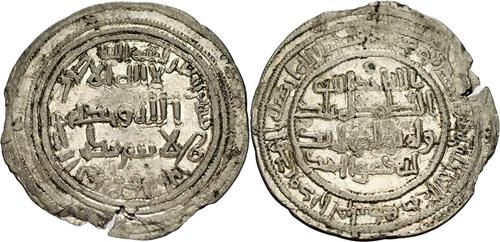
|
Umayyad Caliphate, Silver coinage. AR Dirham (25.8mm, 2.36 g, 3h). Bukhara mint. Dated AH 84? (AD 703). VF, minor losses to edge and some flan delamination .
Islamic Auction 7 - Session One
Lot: 42.
Closing Date: Oct 24 2024 11:00 GMT
Umayyad Silver and Bronze, Silver
Estimate: $ 25 000
BID NOW
|
|
Umayyad Caliphate, Silver coinage. AR Dirham (25.8mm, 2.36 g, 3h). Bukhara mint. Dated AH 84? (AD 703). Obverse: margin reads bism Allah db (sic, for duriba) hadha al-dirham bi-Bukhara fi sanat arba‘t thamanin; five small annulets in outer border / Reverse: wa at beginning of third line of field. VF, minor losses to edge and some flan delamination . Unpublished, believed unique, and the first Umayyad dirham known from the mint of Bukhara.
Two other extremely rare Eastern dirham mints, both similarly unknown to Klat, were also briefly active at this time. These mints are Tukharistan, known from two specimens dated AH 80 (CNG Triton XXI, 9 January 2018, lot 947) and AH ‘8’ (Morton & Eden 69, 10 April 2014, lot 20), and Balkh, known from a specimen with the date read as either AH 87 or 82 (Morton & Eden 79, 21 April 2016, lot 36). The coin offered here exhibits a number of striking similarities with these three pieces, and the style and fabric are clearly close to the Balkh and the Tukharistan ‘8’ dirhams in particular. It is noteworthy that these two coins also have illegible or incomplete dates, which are difficult to read and interpret, much as on the present piece. The year as been tentatively read as AH 84 here; the decade is certain, but the unit is not clearly engraved. AH 82, which would of course fit with the Balkh dirham mentioned above, is another possibility.
The first Muslim armies reached Bukhara during the caliphate of Mu‘awiya, when a force led by ‘Ubaydallah b. Ziyad crossed the Oxus in AH 53/4. ‘Ubaydallah was able to demand tribute from Khatun, who was ruling in Bukhara as regent for her young son Tughshada, and further tribute was exacted two years later by ‘Ubaydallah’s successor, Sa‘id b. ‘Uthman. But our sources are clear that the Muslims were not able to establish permanent control of Bukhara until the mid-80s, when Qutayba b. Muslim led a series of campaigns into Sogdiana and finally overcame Bukharan resistance in AH 87. For two decades before this, the Arab settlers in the neighbouring province of Khurasan had squabbled and fought among themselves while also launching occasional raids across the Oxus - with varying degrees of success. A few years before this coin was struck, the governor Umayya b. ‘Abdallah had been abandoned by his main commander while campagining beyond the Oxus, forcing him to conclude a swift and humiliating peace with Bukhara. His successors, including the celebrated warrior al-Muhallab b. Abi Sufra and his son Yazid, achieved little more than Umayya. But during the early 80s, when this coin was struck, the situation finally began to shift in the Arabs’ favour. Feuding between the local rulers in Transoxiana left them less able to mount a cohesive resistance, while the defeat of the Arab rebel Musa b. ‘Abdallah helped clear the way for Qutayba b. Muslim to launch the sustained assault which would finally see Bukhara securely in Muslim hands.
Closing Date and Time: at 14:13:40 ET.
|
